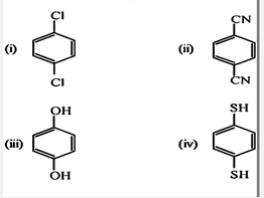Which of the following is/are nonpolar (μ=0) ?




The correct Answer is:A, D
To determine which of the given compounds are nonpolar (with a dipole moment, μ = 0), we need to analyze the molecular structure and symmetry of each compound. Nonpolar molecules typically have symmetrical arrangements of atoms that allow the dipole moments to cancel each other out.
1. Identify the Compounds:
- List the compounds provided in the question. For example, let’s say the compounds are A, B, C, and D.
2. Determine Molecular Geometry:
- For each compound, determine its molecular geometry. This can often be done using VSEPR (Valence Shell Electron Pair Repulsion) theory.
3. Analyze Electronegativity:
- Check the electronegativity values of the atoms in each compound. Nonpolar bonds typically occur between atoms with similar electronegativities.
4. Check for Symmetry:
- Examine the symmetry of the molecular structure. Nonpolar molecules often have symmetrical shapes (like linear, tetrahedral, or octahedral) that allow dipole moments to cancel.
5. Evaluate Dipole Moments:
- If the molecule has polar bonds, assess whether the molecular geometry allows for the cancellation of these dipole moments. If the dipole moments cancel out, the molecule is nonpolar.
6. Conclusion:
- Based on the analysis, conclude which of the compounds are nonpolar.
Example Analysis:
- Compound A: If it is symmetrical (like CO2), it is nonpolar.
- Compound B: If it has polar bonds and is asymmetrical (like H2O), it is polar.
- Compound C: If it is symmetrical (like CH4), it is nonpolar.
- Compound D: If it has polar bonds and is asymmetrical (like NH3), it is polar.
Final Answer:
- The nonpolar compounds from the list are A and C.
- List the compounds provided in the question. For example, let’s say the compounds are A, B, C, and D.
- For each compound, determine its molecular geometry. This can often be done using VSEPR (Valence Shell Electron Pair Repulsion) theory.
- Check the electronegativity values of the atoms in each compound. Nonpolar bonds typically occur between atoms with similar electronegativities.
- Examine the symmetry of the molecular structure. Nonpolar molecules often have symmetrical shapes (like linear, tetrahedral, or octahedral) that allow dipole moments to cancel.
- If the molecule has polar bonds, assess whether the molecular geometry allows for the cancellation of these dipole moments. If the dipole moments cancel out, the molecule is nonpolar.
- Based on the analysis, conclude which of the compounds are nonpolar.
- Compound A: If it is symmetrical (like CO2), it is nonpolar.
- Compound B: If it has polar bonds and is asymmetrical (like H2O), it is polar.
- Compound C: If it is symmetrical (like CH4), it is nonpolar.
- Compound D: If it has polar bonds and is asymmetrical (like NH3), it is polar.
- The nonpolar compounds from the list are A and C.
Similar Questions
Knowledge Check
Which of the following is not correct about relative magnetic permeability (μr)?
AIt is a dimensionless pure ratio.BFor vacuum medium its value is one.CFor ferromagnetic materials of μ>>1DFor paramagnetic materials μr>1
For which of the following molecule significant μ≠0?

View SolutionFor which of the following molecule significant μ≠0 ?

View SolutionFor which of the following molecule significant μ≠0 ?

View SolutionFor which of the following molecules μ≠0

View SolutionWhich of the following can have negative value ?
A. χ
B. μr
C. μ0
D. μr and χ both
View SolutionWhich one of the following is the first zoological mu-seum of India?
View SolutionWhich of the following product of e,h,μ,G ( where μ is permeability ) be taken so that the dimensions of the product are same as that of the speed of light ?
View Solution

